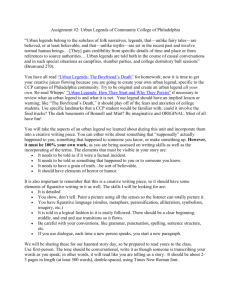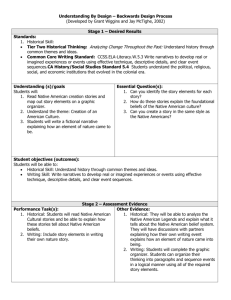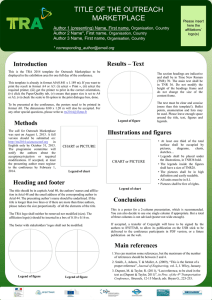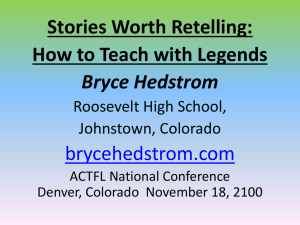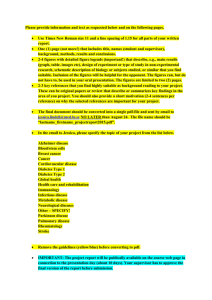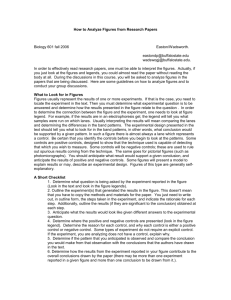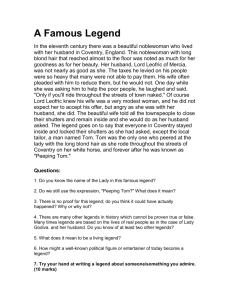Localizing Urban Legends
advertisement
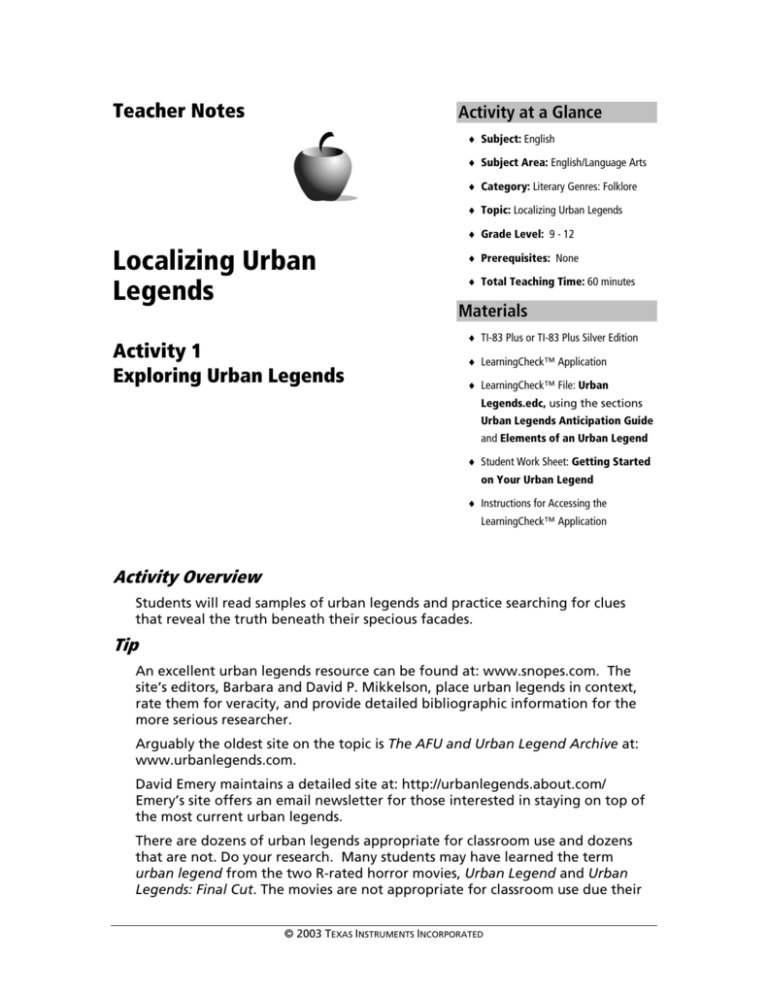
Teacher Notes Activity at a Glance ♦ Subject: English ♦ Subject Area: English/Language Arts ♦ Category: Literary Genres: Folklore ♦ Topic: Localizing Urban Legends ♦ Grade Level: 9 - 12 Localizing Urban Legends Activity 1 Exploring Urban Legends ♦ Prerequisites: None ♦ Total Teaching Time: 60 minutes Materials ♦ TI-83 Plus or TI-83 Plus Silver Edition ♦ LearningCheck™ Application ♦ LearningCheck™ File: Urban Legends.edc, using the sections Urban Legends Anticipation Guide and Elements of an Urban Legend ♦ Student Work Sheet: Getting Started on Your Urban Legend ♦ Instructions for Accessing the LearningCheck™ Application Activity Overview Students will read samples of urban legends and practice searching for clues that reveal the truth beneath their specious facades. Tip An excellent urban legends resource can be found at: www.snopes.com. The site’s editors, Barbara and David P. Mikkelson, place urban legends in context, rate them for veracity, and provide detailed bibliographic information for the more serious researcher. Arguably the oldest site on the topic is The AFU and Urban Legend Archive at: www.urbanlegends.com. David Emery maintains a detailed site at: http://urbanlegends.about.com/ Emery’s site offers an email newsletter for those interested in staying on top of the most current urban legends. There are dozens of urban legends appropriate for classroom use and dozens that are not. Do your research. Many students may have learned the term urban legend from the two R-rated horror movies, Urban Legend and Urban Legends: Final Cut. The movies are not appropriate for classroom use due their © 2003 TEXAS INSTRUMENTS INCORPORATED 2 English/Language Arts – Literary Genres depictions of violence, gore, and sexuality, but you may want to watch them on your own time to get an understanding of how students who may have seen the movie/s conceive of the term urban legend. Directions Before the Activity Begins Send the Urban Legends.edc LearningCheck™ file to the students. Use the Urban Legends Anticipation Guide section of the file to survey the students and promote discussion. Preview the lesson for the students: ♦ Activity 1: Students will read, discuss, and analyze urban legends. ♦ Activity 2: Students will rewrite/adapt existing urban legends in a local setting. ♦ Activity 3: Students will share newly-localized urban legends in a “campfire setting.” Have the students complete the Urban Legends Anticipation Guide, and then initiate a brief introductory discussion about urban legends. During the Activity Students will read samples of urban legends individually before discussing the stories as a class. After the Activity Using the Elements of an Urban Legend section of the LearningCheck™ file (or optional Student Work Sheet), explore the underlying similarities between urban legends. Get the students thinking about the commonalities that run through all the legends they read in class. Homework Give each student a copy of the student work sheet entitled Getting Started on Your Urban Legend. Each student should complete this sheet and prepare a rough draft of her/his urban legend. Students will meet in revision groups tomorrow to discuss rough drafts. © 2003 TEXAS INSTRUMENTS INCORPORATED Student Work Sheet Urban Legends Anticipation Guide Name: ____________________________ Date: ____________________________ 1. What is an urban legend? 2. Have you seen one or both of the following two R-rated horror movies: Urban Legend or Urban Legends: Final Cut? ____Yes ____No 3. Have you heard the story of the escaped killer with a hook for a hand? ____Yes ____No 4. If you answered “Yes” to the previous question, briefly summarize the story. 5. Have you ever retold a story told to you, not knowing if it was actually true? ____Yes ____No 6. If you answered “Yes” to the previous question, briefly summarize the story. 7. Have you ever caught someone telling an urban legend and the person believed he/she was telling a true story? ____Yes ____No 8. If you answer “Yes” to the previous question, briefly describe the person’s reaction to your version of the legend. © 2003 TEXAS INSTRUMENTS INCORPORATED 4 English/Language Arts – Literary Genres Student Work Sheet Elements of an Urban Legend Name: ____________________________ Date: ____________________________ Read a sampling of urban legends and find examples of the urban legend elements listed below. ♦ The source of the story is “a friend of a friend” or some other reasonablesounding chain of acquaintances and/or relatives. ♦ The setting is contemporary. ♦ The story is alleged to be true. It has an air of plausibility to it. ♦ Despite the seeming plausibility, the story is too good to be true. There is at least one key detail that is highly implausible or defies common sense. © 2003 TEXAS INSTRUMENTS INCORPORATED Activity 1: Exploring Urban Legends 5 ♦ The urban legend has a moral and features people being punished for violating societal taboos. ♦ The story explains why this otherwise-newsworthy event was not covered by national or local news. ♦ The story has a dramatic ending that is just a little too perfect. © 2003 TEXAS INSTRUMENTS INCORPORATED 6 English/Language Arts – Literary Genres Student Work Sheet Getting Started on Your Urban Legend Name: ____________________________ Date: ____________________________ Your assignment is to take one of the urban legends you read, and retell the story as if it happened in your community. If you know of a recent urban legend that is alleged to have taken place in your community, you may use that to complete this assignment. Do not be afraid to embellish. All good storytellers take stories, transform them, and make them their own. The questions below will help you brainstorm for your urban legend. ♦ Who told you the urban legend? (Have fun coming up with a chain of acquaintances and/or relatives.) ♦ Where specifically in the community did the urban legend take place? ♦ The urban legend, though plausible, must ultimately be too good to be true. What is one clue you will give to the reader/listener that lets him/her know the story is fictitious? ♦ Who is the person who is punished in your urban legend? What societal taboo does the person violate? ♦ Why was this extraordinary and newsworthy event ignored by journalists? © 2003 TEXAS INSTRUMENTS INCORPORATED Activity 1: Exploring Urban Legends 7 ♦ How does your urban legend end? (Remember, urban legends have neat and tidy endings that seem a little too perfect.) © 2003 TEXAS INSTRUMENTS INCORPORATED 8 English/Language Arts – Literary Genres Accessing the LearningCheck™ Application on a TI-83 Plus Device The following procedure enables you to access the LearningCheck™ Application. It assumes that the software is already installed on the device. 1. Turn on the device and press the Apps key to display this screen. Select the LearnChk Application by highlighting the selection number using } †. Press Í. 2. Press Í to move past the title screen. The Assignment List is displayed. Use } † to highlight the desired assignment (Theme in this example), and then press Í. 3. Enter your ID to sign in, and then press Í to open the file. 4. The first entry gives instructions for the assignment. Highlight this option, and then press Í to open it. Read the section instructions. Use † to scroll down the page. (The long bar and down arrow on the left side indicates there is more text to view that is not displayed on the screen.) 5. To continue to the assessment questions, press NEXT (using the s key.) Press ANS to move the cursor into the answer box. Note: If you are not using a TI Keyboard, remember to press the ƒ key to type letters. © 2003 TEXAS INSTRUMENTS INCORPORATED Activity 1: Exploring Urban Legends 6. Press NEXT to continue to the next question. When all questions in the file are answered, the LearningCheck™ Application redisplays the list of questions in the file. © 2003 TEXAS INSTRUMENTS INCORPORATED 9
